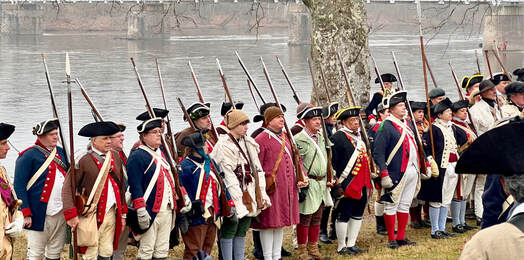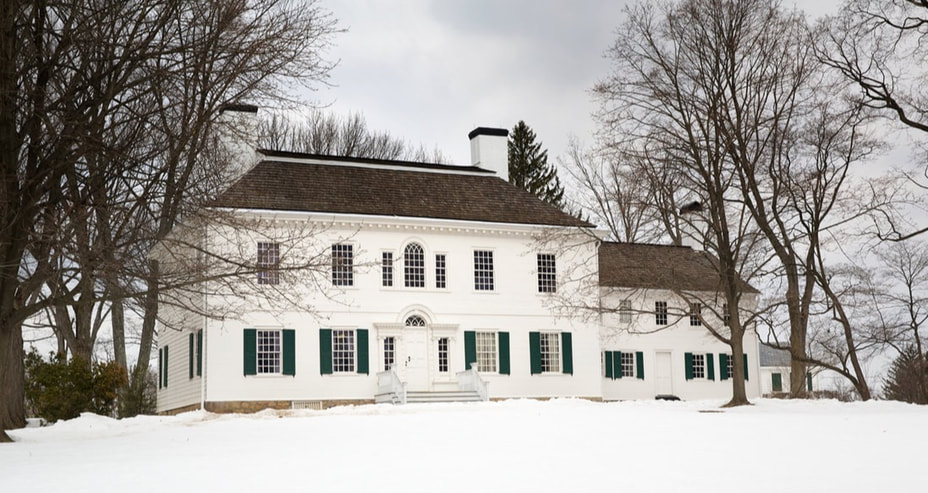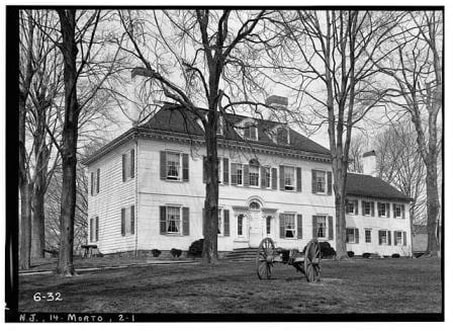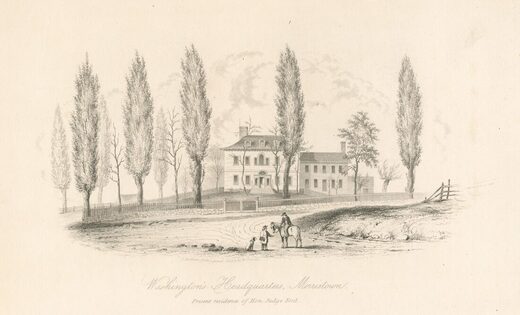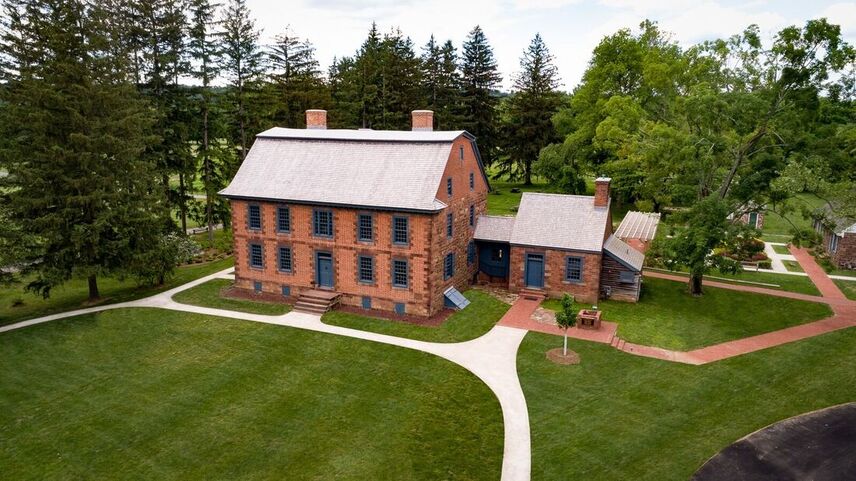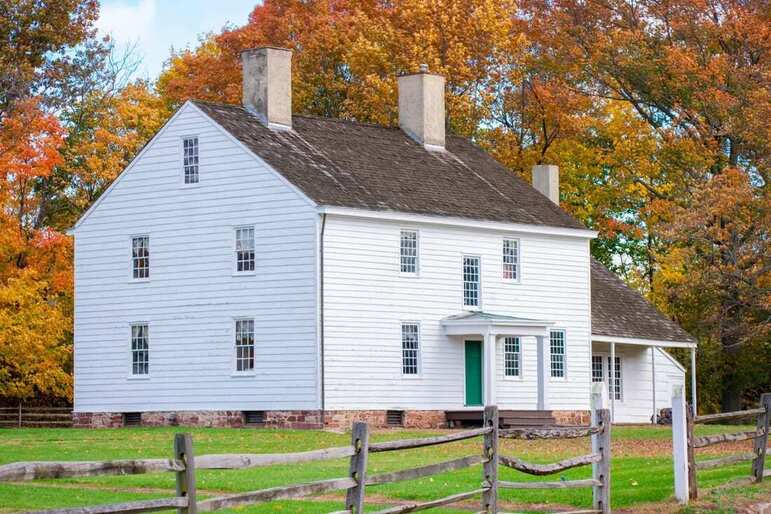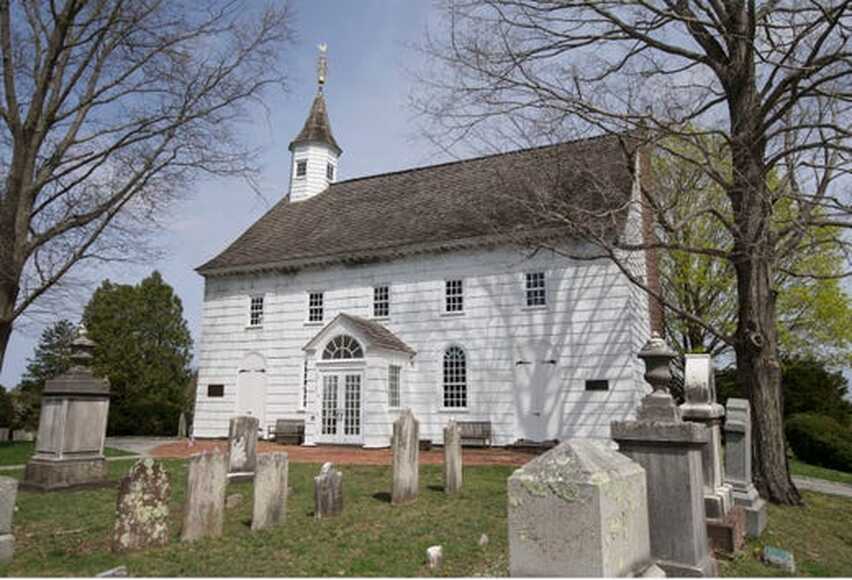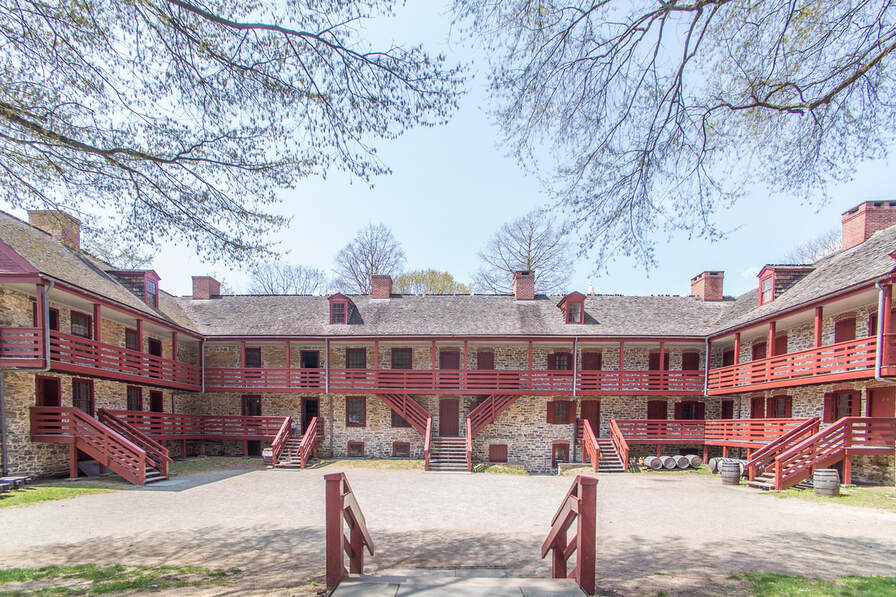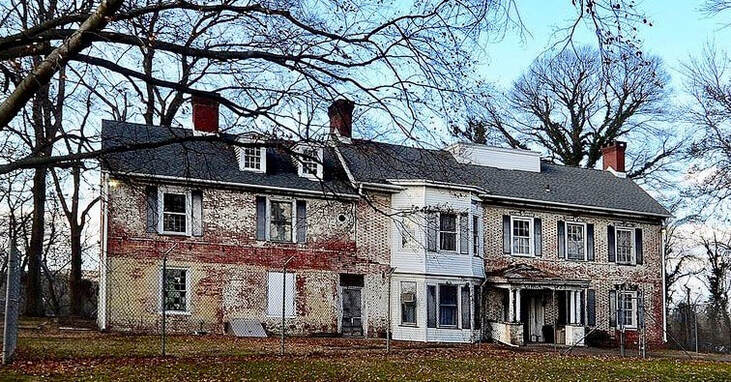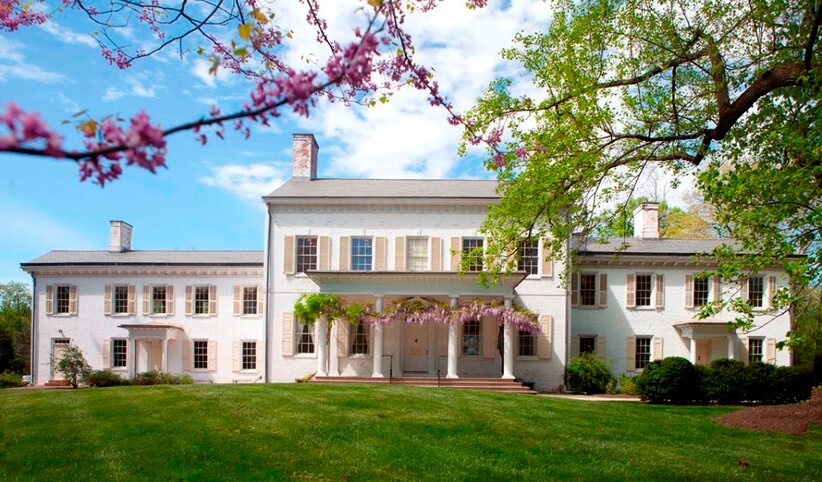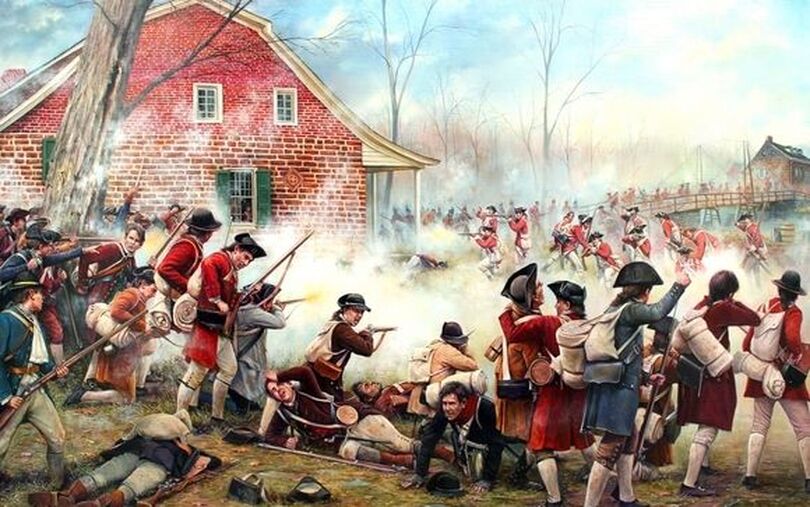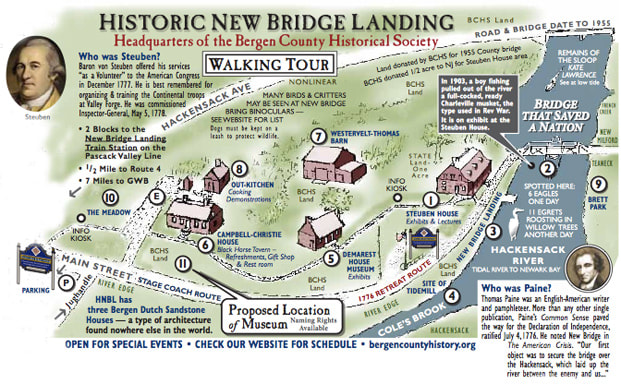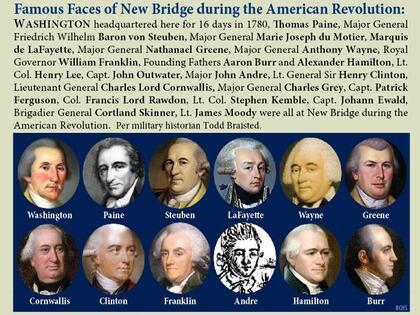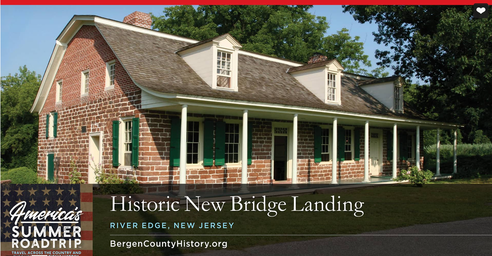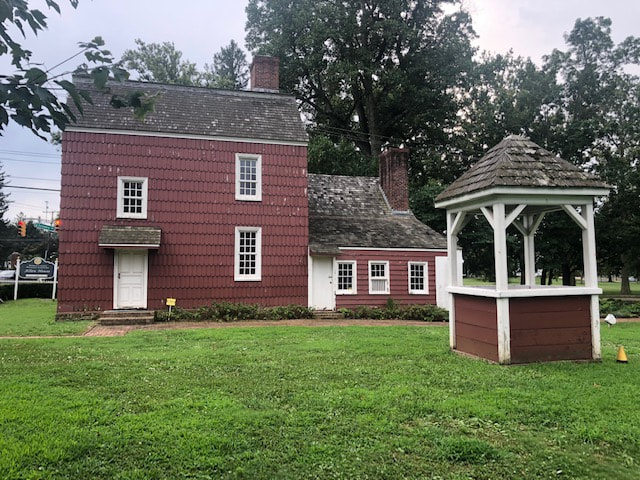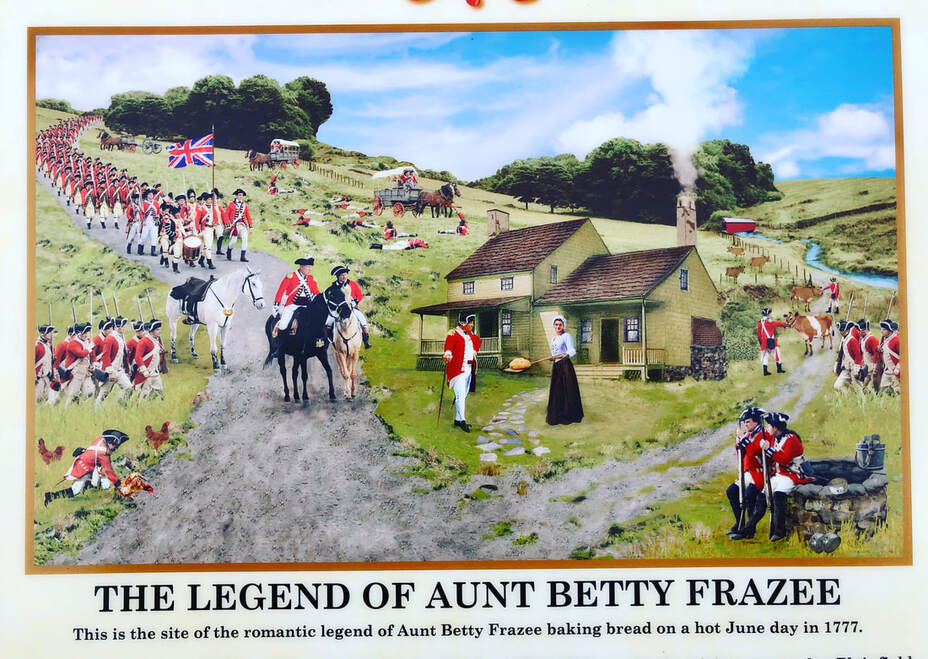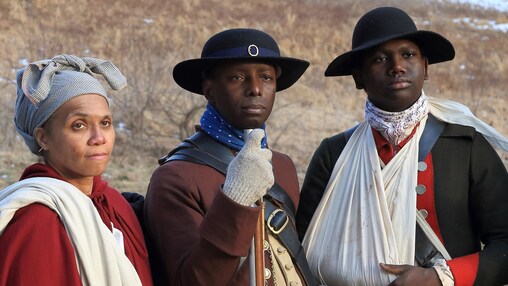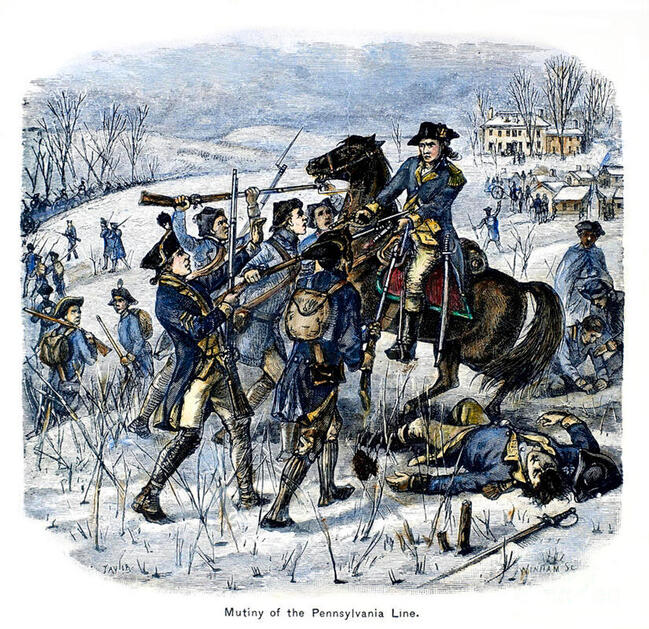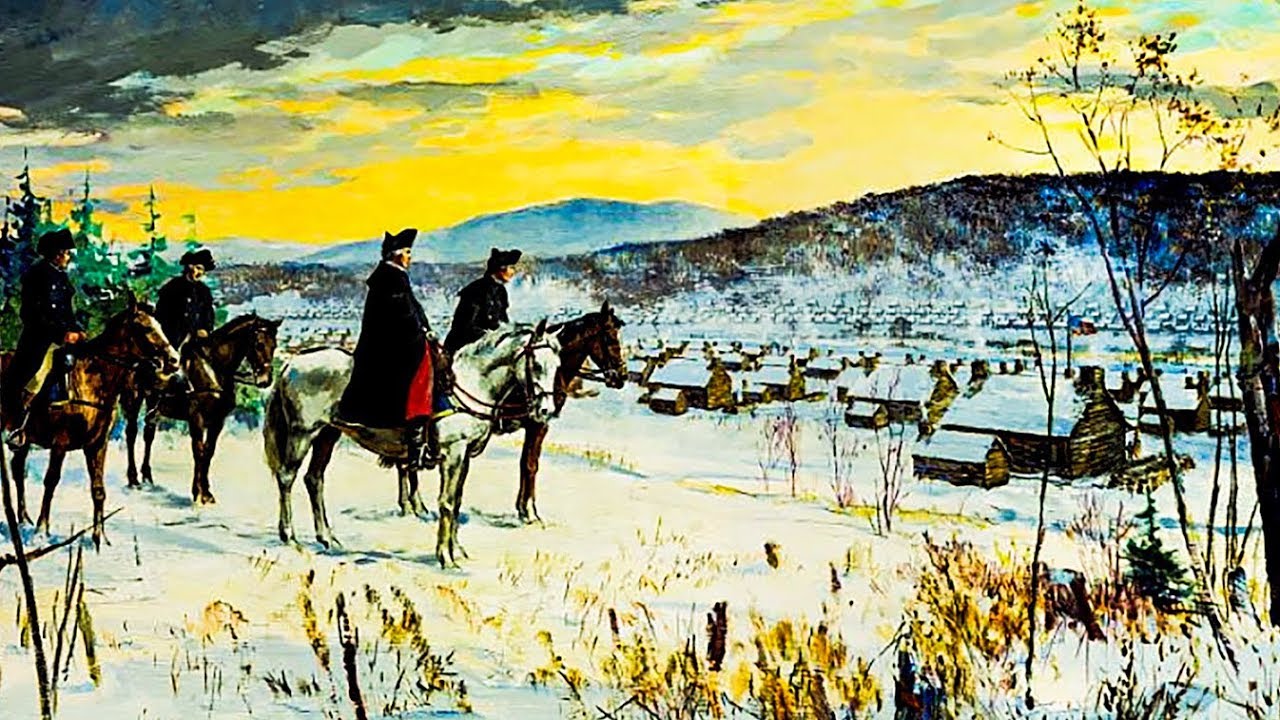Historic profiles
A sampling of important locations across New Jersey that gives
a glimpse of your travel destinations along the
NJ American Revolution Geo Trail.
A sampling of important locations across New Jersey that gives
a glimpse of your travel destinations along the
NJ American Revolution Geo Trail.
DE S T I N A T I O N PROFILE
First Independents Day @ Raritan Landing, NJ
Following the battle of Monmouth on June 28, 1778, General Washington moved his 11,000 continental soldiers north and rested along
the cool waters of the Raritan River in Piscataway. Washington's made his headquarters at Ross Hall, built in 1739, where he issued daily orders.
The most significant on July 3, 1778, dealt with the celebration of the second anniversary of the Declaration of Independence
when he ordered the first official celebration of American Independence Day.
On July 3, 1778 Washington issued the following order:
“Tomorrow the anniversary of the Declaration of Independence will be celebrated by the firing of 13 pieces of cannon and a feu de joie of the whole line…soldiers are to make the best appearance possible. A double allowance of rum will be served out.”
This order marks the first time America’s army recognized Independence Day and the first true celebration of the holiday!
First Independents Day @ Raritan Landing, NJ
Following the battle of Monmouth on June 28, 1778, General Washington moved his 11,000 continental soldiers north and rested along
the cool waters of the Raritan River in Piscataway. Washington's made his headquarters at Ross Hall, built in 1739, where he issued daily orders.
The most significant on July 3, 1778, dealt with the celebration of the second anniversary of the Declaration of Independence
when he ordered the first official celebration of American Independence Day.
On July 3, 1778 Washington issued the following order:
“Tomorrow the anniversary of the Declaration of Independence will be celebrated by the firing of 13 pieces of cannon and a feu de joie of the whole line…soldiers are to make the best appearance possible. A double allowance of rum will be served out.”
This order marks the first time America’s army recognized Independence Day and the first true celebration of the holiday!
DE S T I N A T I O N PROFILE
Ford Mansion - Washington's Headquarters
Ford Mansion - This large Georgian style home was built in the early 1770's for Jacob Ford, Jr., an iron manufacturer. Mr. Ford also served as a colonel in the Morris County Militia during the Revolutionary War. Ford died in January 1777 while 35 soldiers from Delaware were briefly quartered in the house. In December 1779, Mr. Ford's widow, Theodosia, allowed General Washington to use her home as his headquarters during the winter of 1779-1780. While Mrs. Ford and her four children moved into two rooms of the house, General Washington, his wife Martha, five aides-de-camp, eighteen servants, a number of visiting dignitaries and sometimes guards took over the rest of the house.
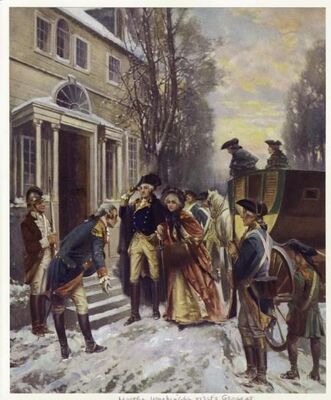
"After the battles of Trenton and Princeton, George Washington picked the Ford Mansion and Jockey Hollow in Morristown, NJ as the site of his winter encampment for the Continental, where they remained from January 6 to May 28, 1777."
Now the National Park Service Washingtons Headquarters Museum
Explore this and many other historic locations!
Morristown Link
DE S T I N A T I O N PROFILE
Dey Mansion - Washington's Headquarters
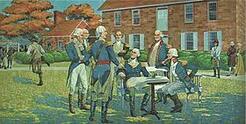
The Dey Mansion ~ Washington's Headquarters – is a historic house museum that served as General George Washington’s headquarters during the summer and fall of 1780, and played a significant role in the American Revolution. Today, under the supervision of the Passaic County Board of Chosen Freeholders, the mansion hosts tours, lectures, and special programs – highlighting life in Colonial America, the events and people of the American Revolution, and the value of historic preservation.
The Dey Mansion (pronounced dye), located in Wayne played an integral role in the American Revolution. Built by Col. Theunis Dey's father Dirck Dey in the 1770s. It served as Washington's Headquarters on several occasions, once from July 1 through July 28, 1780 and again from October 8 through November 27, 1780. George Washington stayed at the Dey Mansion during the American Revolution as one of his Headquarters. This area was chosen because its location, as well as its abundance of food and forage in the surrounding area.
During his stay Washington and his advisers which included Alexander Hamilton, Robert H. Harrison, Tench Tilghman, David Humphreys and James McHenry used the four rooms on the south-eastern side of the mansion for their bedrooms as well as their military war rooms. Washington also had numerous visitors while at the Dey Mansion, those of which include the Marquis de Lafayette, General Anthony Wayne, Major General Lord Stirling, Alexander Scammel, Washington’s Adjutant General, and Richard Kidder Meade an aid de camp to Washington while stationed at the house.
The Dey Mansion (pronounced dye), located in Wayne played an integral role in the American Revolution. Built by Col. Theunis Dey's father Dirck Dey in the 1770s. It served as Washington's Headquarters on several occasions, once from July 1 through July 28, 1780 and again from October 8 through November 27, 1780. George Washington stayed at the Dey Mansion during the American Revolution as one of his Headquarters. This area was chosen because its location, as well as its abundance of food and forage in the surrounding area.
During his stay Washington and his advisers which included Alexander Hamilton, Robert H. Harrison, Tench Tilghman, David Humphreys and James McHenry used the four rooms on the south-eastern side of the mansion for their bedrooms as well as their military war rooms. Washington also had numerous visitors while at the Dey Mansion, those of which include the Marquis de Lafayette, General Anthony Wayne, Major General Lord Stirling, Alexander Scammel, Washington’s Adjutant General, and Richard Kidder Meade an aid de camp to Washington while stationed at the house.
Website: Deymansion.org / Instagram: Instagram.com/deymansion / Facebook: Facebook.com/deymansion
- Hours of Operation:
- Monday – Tuesday: Closed
- Wednesday – Sunday: 9:00am – 5:00pm
- Address: 199 Totowa Road, Wayne, NJ 07470
- Tours: Tours run for approximately one hour and are scheduled at the following times:
- 10:00, 11:00, 1:00, 2:00, 3:00pm 4:00pm
- Adults - $5.00, Children (Ages 6 to 16) - $3.00, Children (Ages 5 and Under) - Free Members & Patrons - Free
|
|
|
DE S T I N A T I O N PROFILE
The Wallace House - Washington's Headquarters
.General George Washington used the Wallace House as his headquarters from December 11, 1778, to June 3, 1779, during the Second Middlebrook Encampment. However, he left here from December 22 until February 5, to meet with the Continental Congress in Philadelphia.
In the winter of 1778, General George Washington's Continental Army encamped at Middlebrook in the Watchung Mountains, just 3 miles from Hope Farm. Washington chose the area because it was a defensible one, with a good network of roads, plenty of timber for the soldiers' huts, and a sympathetic populace.
In the winter of 1778, General George Washington's Continental Army encamped at Middlebrook in the Watchung Mountains, just 3 miles from Hope Farm. Washington chose the area because it was a defensible one, with a good network of roads, plenty of timber for the soldiers' huts, and a sympathetic populace.
DE S T I N A T I O N PROFILE
Old Tennent Church
Having had continuous existence for more than ten generations; The congregation was formed in 1692 by a group of Scottish Dissenters who had fled their homeland to escape James II's severe persecution for their beliefs. It has occupied its existing building since 1751, and the structure has undergone little fundamental change. The church once served as a hospital during an engagement in the War for Independence—the Battle of Monmouth—which raged around it on June 28, 1778.
DE S T I N A T I O N PROFILE
Old Barracks Museum
Must See! Of the five barracks buildings erected in New Jersey during the French & Indian War, the Trenton Barracks is the only one that has survived. The twice restored former barracks building is adjacent to the New Jersey State House on South Willow Street and is now known as the "Old Barracks." The barracks stands today practically the same as when it was originally built and is furnished in the style of the period. The upper floor of the officer's quarters is devoted to the Old Barracks Museum.
Construction of the barracks began on 31 May 1759 and finished in March of 1759. A substantial addition for officers was added in December 1759. The Highlanders were the first troops quartered there in 1759. The barracks continued in use until the formal end of Pontiac's War in 1766.
During the Revolution American soldiers, English soldiers, Hessian mercenaries, Tory refugees, and prisoners of war were sheltered in the building.
British Light Dragoons and Hessians troops were stationed at the barracks on 26 Dec 1776 when Patriot troops took the barracks by surprise and routed the British. The British commander, Colonel Johann G. Rall, was mortally wounded and about 900 British prisoners were taken to Newton across the Delaware River. The Patriots then withdrew from Trenton Barracks. In 1781 the barracks was used to housed some 600 wounded Patriots from the battles in the Virginia campaigns.
After the close of the Revolution the building was not used, and was sold in 1787 by the State to William Ogden and William Harrison. Front Street was extended from Willow Street to the State House, and a portion of the structure was demolished during the lengthing of Front Street. This left the north wing standing on one side of the street and the south wing and part of the main structure on the other side. The barracks building became a museum in 1903, was restored in 1916, and restored again in 1998. The restorations removed the front street extension and rebuilt the destroyed sections of the barracks so that the building now replicates the 1759 structure.
The Old Barracks Museum is open year-round, SEE NEW COVID HOURS BELOW:
PLEASE CALL AHEAD FOR ADVANCED RESERVATIONS TO ENTER THE PROPERTY THIS IS DUE TO COVID RESTRICTIONS.
YOU CAN MENTION GEOCACHING, THEY ARE HAPPY TO HAVE VISITORS!
The Old Barracks Museum | 101 Barrack Street, Trenton, NJ 08608 | 609-396-1776 | [email protected] Open Tuesday - Saturday 10 AM - 5 PM | Advance tickets required Closed Sundays, Jan. 1, Thanksgiving, Dec. 24, Dec. 25
101 Barrack Street, Trenton, NJ 08608 609-396-1776
Open Monday - Saturday 10 AM - 5 PM | Tours begin on the hour, last tour begins at 4 PM
Closed Sundays, Jan. 1, Thanksgiving, Dec. 24, Dec. 25
website link
Construction of the barracks began on 31 May 1759 and finished in March of 1759. A substantial addition for officers was added in December 1759. The Highlanders were the first troops quartered there in 1759. The barracks continued in use until the formal end of Pontiac's War in 1766.
During the Revolution American soldiers, English soldiers, Hessian mercenaries, Tory refugees, and prisoners of war were sheltered in the building.
British Light Dragoons and Hessians troops were stationed at the barracks on 26 Dec 1776 when Patriot troops took the barracks by surprise and routed the British. The British commander, Colonel Johann G. Rall, was mortally wounded and about 900 British prisoners were taken to Newton across the Delaware River. The Patriots then withdrew from Trenton Barracks. In 1781 the barracks was used to housed some 600 wounded Patriots from the battles in the Virginia campaigns.
After the close of the Revolution the building was not used, and was sold in 1787 by the State to William Ogden and William Harrison. Front Street was extended from Willow Street to the State House, and a portion of the structure was demolished during the lengthing of Front Street. This left the north wing standing on one side of the street and the south wing and part of the main structure on the other side. The barracks building became a museum in 1903, was restored in 1916, and restored again in 1998. The restorations removed the front street extension and rebuilt the destroyed sections of the barracks so that the building now replicates the 1759 structure.
The Old Barracks Museum is open year-round, SEE NEW COVID HOURS BELOW:
PLEASE CALL AHEAD FOR ADVANCED RESERVATIONS TO ENTER THE PROPERTY THIS IS DUE TO COVID RESTRICTIONS.
YOU CAN MENTION GEOCACHING, THEY ARE HAPPY TO HAVE VISITORS!
The Old Barracks Museum | 101 Barrack Street, Trenton, NJ 08608 | 609-396-1776 | [email protected] Open Tuesday - Saturday 10 AM - 5 PM | Advance tickets required Closed Sundays, Jan. 1, Thanksgiving, Dec. 24, Dec. 25
101 Barrack Street, Trenton, NJ 08608 609-396-1776
Open Monday - Saturday 10 AM - 5 PM | Tours begin on the hour, last tour begins at 4 PM
Closed Sundays, Jan. 1, Thanksgiving, Dec. 24, Dec. 25
website link
DE S T I N A T I O N PROFILE
Washington Crossing State Park
General George Washington and the Continental Army crossed the Delaware river near The Johnson Ferry house which is the
only remaining structure on the NJ side that stood during the crossing. It took until almost 4 a.m. for everyone to make it across the river, its alleged that Washington and his officers met in the house during the crossing.
It was hours behind the plan's schedule, and the army still had the nine-mile march to Trenton ahead of them. The weather made the march to Trenton a difficult one, they did not reach Trenton to attack until 8 a.m., well after sunrise.
However, Washington's luck had held out, and they still surprised the Hessians and were victorious at what is known as the first Battle of Trenton. Washington's army marched back and then recrossed the Delaware River into Pennsylvania with about 900 Hessian prisoners.
Thank you to all our historic New Jersey Division of Parks and Forestry location friends. Say hello to
Historian Clay Craighead and Johnson Ferry House Curator Nancy Seperley when visiting.
see geocache page here
The 10 Days That Changed The World, Washington's Crossing the Delaware
A period of just ten days from December 25, 1776 to January 3, 1777 — Washington's brave soldiers would win a series of victories at Trenton and Princeton that were glorious indeed. These Ten Crucial Days proved instrumental to rekindling Patriot morale and keeping the cause for American independence alive in the wake of early defeats.
see geocache page here
see geocache page here
Christmas Day 1776 was a turning point in America's fight to become independent. The significance of the Continental Army's 1776 Christmas-night crossing of the Delaware River by George Washington's Continental Army to attack Hessian forces in New Jersey and the American victories at Trenton and Princeton are recounted. The film recounts this dramatic escape — one immortalized in Emanuel Leutze's epic painting — along with the three American victories at the Battle of Trenton, and the lesser-known Second Battle of Trenton and Battle of Princeton. The events of these 10 days forever altered the course of history and marked a major turning point in America's battle for independence. Ten Crucial Days is a production of Kean University, in partnership with the New Jersey Historical Commission. Additional funding is provided by the Brotherton Trust and AT&T. The series is narrated by Willie Geist, and produced by PCK Media. For more information about New Jersey's 350th Anniversary, visit www.officialnj350.com.
DE S T I N A T I O N PROFILE
THE WHITE HILL MANSION
SOLDIERS, GANGSTERS, AND GHOSTS!
The White Hill Mansion is one of the NJ American Revolution Geo Trail locations, listed on the New Jersey State Register of Historic Places.
Partnering with this amazing location is very exciting, as its filled with centuries of history from the Revolutionary War, Continental, British, and Hessians Soldiers, to prohibition, speak easy, a brothel, gangsters, murders and of course GHOSTS!
It was exciting touring this historic mansion recently, hearing compelling stories of what took place at the mansion during the Revolutionary War. By the mid-eighteenth century "White Hill" was a small port with a commercial wharf. The owner Mary Field entertained
Commodore Barry and Commodore Read of the Continental Navy. White Hill was invaded by the British, and protection by the
Hessian commander Count von Donop.
Over the intervening years, White Hill mansion had a brothel, speakeasy during prohibition and frequented by gangsters, eventually enlarged and used as a boarding house and restaurant. The mansion has been closed for years and is under preservation and restoration.
Today, many ghost hunter groups have been at the mansion. They will be opening up for group ghost tours later this year. I'm very happy to partner with the dedicated folks at The White Hill Mansion and look forward to developing an ongoing relationship.
John Neale ~ SAR, "Old Navy", President NNJC.org, founder and creator of The NJ American Revolution Geo~Trail
and njpatriots.org.
The White Hill Mansion is one of the NJ American Revolution Geo Trail locations, listed on the New Jersey State Register of Historic Places.
Partnering with this amazing location is very exciting, as its filled with centuries of history from the Revolutionary War, Continental, British, and Hessians Soldiers, to prohibition, speak easy, a brothel, gangsters, murders and of course GHOSTS!
It was exciting touring this historic mansion recently, hearing compelling stories of what took place at the mansion during the Revolutionary War. By the mid-eighteenth century "White Hill" was a small port with a commercial wharf. The owner Mary Field entertained
Commodore Barry and Commodore Read of the Continental Navy. White Hill was invaded by the British, and protection by the
Hessian commander Count von Donop.
Over the intervening years, White Hill mansion had a brothel, speakeasy during prohibition and frequented by gangsters, eventually enlarged and used as a boarding house and restaurant. The mansion has been closed for years and is under preservation and restoration.
Today, many ghost hunter groups have been at the mansion. They will be opening up for group ghost tours later this year. I'm very happy to partner with the dedicated folks at The White Hill Mansion and look forward to developing an ongoing relationship.
John Neale ~ SAR, "Old Navy", President NNJC.org, founder and creator of The NJ American Revolution Geo~Trail
and njpatriots.org.
Admission: Adults: $8, Veterans & Seniors: $5, Members, Active Military and Fieldsboro residents: Free
Hours: By appointment
Address: 217 Burlington Street, Fieldsboro NJ 08505
More information on the website click HERE
Hours: By appointment
Address: 217 Burlington Street, Fieldsboro NJ 08505
More information on the website click HERE
Paranormal Lockdown
Nick & Katrina Connect With A Child
At White Hill Mansion |
Nick & Katrina Connect With A Child
At White Hill Mansion |
DE S T I N A T I O N PROFILE
Morven Museum and Garden
A National Historic Landmark
Home to one of the signers of the Declaration of Independence and to five New Jersey governors, Morven has played a role in the history of New Jersey and the nation for more than 250 years.
Morven was built by Richard Stockton (1730–1781), a signer of the Declaration of Independence, in the 1750s on property granted to his grandfather by William Penn (1644–1718) in 1701.
ADDRESS: Stockton Street,Princeton, New Jersey 08540
T 609.924.8144
morven.org
HOURS OF OPERATION: Wednesday – Sunday, 10 a.m. – 4 p.m.
Tours with Admission fee of the first floor are given on the hour at 11 a.m., 12 noon, 1 p.m. and 2 p.m. The second floor is self-guided.
photo credit: Morven Mansion
Morven was built by Richard Stockton (1730–1781), a signer of the Declaration of Independence, in the 1750s on property granted to his grandfather by William Penn (1644–1718) in 1701.
ADDRESS: Stockton Street,Princeton, New Jersey 08540
T 609.924.8144
morven.org
HOURS OF OPERATION: Wednesday – Sunday, 10 a.m. – 4 p.m.
Tours with Admission fee of the first floor are given on the hour at 11 a.m., 12 noon, 1 p.m. and 2 p.m. The second floor is self-guided.
photo credit: Morven Mansion
DE S T I N A T I O N PROFILE
THE BRIDGE THAT SAVED A NATION & STEUBEN HOUSE
Retreating across NJ from escaping Fort Lee, crossing at New Bridge saved Washington and his army from its certain defeat in November 1776, inspiring Thomas Paine's American Crisis. "Our first object was to secure the bridge over the Hackensack, which laid up the river between the enemy and us..." New Bridge was a strategic river crossing throughout the American Revolution.
New Bridge served as a battleground, fort, encampment ground, military headquarters, and intelligence-gathering post in every year of the American Revolution. The Steuben House, a state historic site, is the only extant building remaining from the 1776 Retreat through Bergen County, the Retreat to Victory. The house was Washington's HQ while 14,000 soldiers camped nearby for 2 weeks as seen in this 1780 Painting of the Retreat by New Bridge and Steuben Hs by B. Spencer Newman. Bergen County History Link
ADDRESS:
1201 Main St, River Edge, NJ 07661 (Use for directions)
US Mail: BCHS, PO Box 55, River Edge, NJ 07661-0055
PHONE: (201) 343-9492, answering machine
EMAIL: [email protected]
New Bridge served as a battleground, fort, encampment ground, military headquarters, and intelligence-gathering post in every year of the American Revolution. The Steuben House, a state historic site, is the only extant building remaining from the 1776 Retreat through Bergen County, the Retreat to Victory. The house was Washington's HQ while 14,000 soldiers camped nearby for 2 weeks as seen in this 1780 Painting of the Retreat by New Bridge and Steuben Hs by B. Spencer Newman. Bergen County History Link
ADDRESS:
1201 Main St, River Edge, NJ 07661 (Use for directions)
US Mail: BCHS, PO Box 55, River Edge, NJ 07661-0055
PHONE: (201) 343-9492, answering machine
EMAIL: [email protected]
Historic New Bridge Landing Movie
A strategically-important site during the Revolutionary War, New Bridge and the Steuben House served as a battleground, fort, encampment ground, military headquarters, and intelligence-gathering post in every year of the American Revolution. The Steuben House, a state historic site, is the only extant building remaining from the 1776 Retreat through Bergen County, the “Retreat to Victory,” and the house later served as Washington’s HQ in 1780. Join the Bergen County Historical Society as we take you on a tour of our historic 17th and 18th century Dutch sandstones homes, our unique Jersey Dutch collections, and visit the “bridge that saved a nation.” bergencountyhistory.org
A strategically-important site during the Revolutionary War, New Bridge and the Steuben House served as a battleground, fort, encampment ground, military headquarters, and intelligence-gathering post in every year of the American Revolution. The Steuben House, a state historic site, is the only extant building remaining from the 1776 Retreat through Bergen County, the “Retreat to Victory,” and the house later served as Washington’s HQ in 1780. Join the Bergen County Historical Society as we take you on a tour of our historic 17th and 18th century Dutch sandstones homes, our unique Jersey Dutch collections, and visit the “bridge that saved a nation.” bergencountyhistory.org
America's Summer Road trip ~ Historic New Bridge Landing Video link:
DE S T I N A T I O N PROFILE
Tavern Museum at the Allen House
The Allen House is located in Shrewsbury, Monmouth County. The house which would later function as a tavern, built c. 1710 as a second residence for the Stillwell family of NY. Richard, a wealthy merchant, and his wife Mercy had eight children who were brought up primarily in Shrewsbury.
By 1754, after Richard and Mercy had died, their heirs sold the property to Josiah Halstead who transformed the home into the Blue Ball Tavern, "the most noted tavern in Shrewsbury." Taverns served as community centers in the 18th century as much as places to drink and eat.
During the American Revolutionary War in 1779, a Loyalist party raided the tavern where Continental troops were quartered. They killed 3 and captured 9 in what would become known as the Allen House Massacre. The house is furnished to reflect its use as a colonial tavern.
The tavern was added to the National Register of Historic Places on May 8, 1974.
The house is one of several houses owned and operated as a historic house museum by the
Monmouth County Historical Association.
Address: Historic Four Corners, 400 Sycamore Avenue, Shrewsbury, NJ 07702
Days of Operation: The historic houses are open on a rotating basis each month (May through September). Please call to ensure that they are open the week you are visiting. The Tavern Museum at Allen House is scheduled to be open the first weekend (Friday, Saturday, and Sunday) every month from 1:00 PM to 4:00 PM. Parking Information: Parking available behind the Allen House
Admission: Adults: $5.00, Seniors: $2.50, Students: $2.50, Members: Free, Children under 6: Free
By 1754, after Richard and Mercy had died, their heirs sold the property to Josiah Halstead who transformed the home into the Blue Ball Tavern, "the most noted tavern in Shrewsbury." Taverns served as community centers in the 18th century as much as places to drink and eat.
During the American Revolutionary War in 1779, a Loyalist party raided the tavern where Continental troops were quartered. They killed 3 and captured 9 in what would become known as the Allen House Massacre. The house is furnished to reflect its use as a colonial tavern.
The tavern was added to the National Register of Historic Places on May 8, 1974.
The house is one of several houses owned and operated as a historic house museum by the
Monmouth County Historical Association.
Address: Historic Four Corners, 400 Sycamore Avenue, Shrewsbury, NJ 07702
Days of Operation: The historic houses are open on a rotating basis each month (May through September). Please call to ensure that they are open the week you are visiting. The Tavern Museum at Allen House is scheduled to be open the first weekend (Friday, Saturday, and Sunday) every month from 1:00 PM to 4:00 PM. Parking Information: Parking available behind the Allen House
Admission: Adults: $5.00, Seniors: $2.50, Students: $2.50, Members: Free, Children under 6: Free
DE S T I N A T I O N PROFILE
Frazee House History: Two Lords and a Lady

This film below by John Fazio recounts the revolutionary war Battle of The Short Hills. The Frazee House, a nationally designated historic site, is significant for one woman’s rumored role in the American Revolution, and as an excellent example of 18th-century vernacular residential architecture.
The house is reported to have been constructed circa 1720-1740 by the husband of Elizabeth (Betty) Frazee. As the legend holds, after the Battle of Short Hills, General Cornwallis and his troops passed by the house while marching toward the Watchung mountains, located a few miles to the north.
Known to the locals as a prolific baker, Aunt Betty was baking bread at the time. Hungry and tired, the troops smelled the bread and Cornwallis approached her stating, "I want the first loaf of bread that next comes from that oven."
Betty is said to have replied, “Sir, I give you this bread through fear, not in love.”
Evidently impressed by her courage, Cornwallis is said to have stated, “Not a man in my command shall touch a single loaf.”
While history offers evidence that Betty lived in the house and did, indeed, bake bread, the story of the actual conversation is not authenticated by primary source documents.
The house is reported to have been constructed circa 1720-1740 by the husband of Elizabeth (Betty) Frazee. As the legend holds, after the Battle of Short Hills, General Cornwallis and his troops passed by the house while marching toward the Watchung mountains, located a few miles to the north.
Known to the locals as a prolific baker, Aunt Betty was baking bread at the time. Hungry and tired, the troops smelled the bread and Cornwallis approached her stating, "I want the first loaf of bread that next comes from that oven."
Betty is said to have replied, “Sir, I give you this bread through fear, not in love.”
Evidently impressed by her courage, Cornwallis is said to have stated, “Not a man in my command shall touch a single loaf.”
While history offers evidence that Betty lived in the house and did, indeed, bake bread, the story of the actual conversation is not authenticated by primary source documents.
NJ Revolutionary War Profile
Patriots of Color during the American Revolution
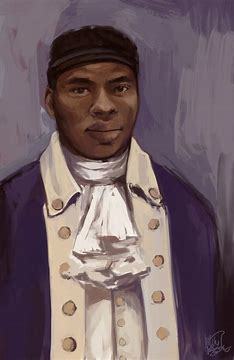
During the American Revolution, approximately five to eight thousand people of African descent supported American liberty. They ranged from Crispus Attucks to James Armistead Lafayette (the Black double agent who spied on Charles Cornwallis and Benedict Arnold for the Marquis de Lafayette). Many African Americans enlisted as soldiers, while others supported the army as spies, hostlers, blacksmiths, wagoners, laborers, carpenters, artificers, free and enslaved servants, and in innumerable other positions. While they fought for independence, many had the opportunity to fight for their own freedom as well.
Cato Howe was an enslaved African American Black Patriot spy and courier during the American Revolution. Cato's enslaver, Hercules Mulligan, gathered intelligence through his personal connections as well as clients at his New York City tailoring shop, and Cato carried the information on horseback to Continental Army officers and other revolutionaries, including Alexander Hamilton and George Washington, and often through British-held territory. Cato's messages are credited with likely saving Washington's life on two occasions. Other than his intelligence activities with Mulligan, little definite information about Cato is available, though an excavation of his home after the war provides historians with more information about his life after the war.
Attempts on Washington During the winter of 1779, a British officer came into Mulligan's New York tailor shop late in the evening looking for a watch coat. During the ensuing conversation, the officer shared a British plan to attack and capture Washington the following day. Cato was quickly dispatched to alert Washington, who moved his troops and thwarted the attack.
In 1780, Mulligan received intelligence from his brother Hugh, who worked for British army contractor Kortright and Company, that the British planned to intercept Washington in New London CT. on his way to meet with General Rochambeau. Cato carried the message to Washington, who rerouted in such a way to distract the British from the French landing in Newport RI.
For more information from Valley Forge National Historical Park LINK
Cato Howe was an enslaved African American Black Patriot spy and courier during the American Revolution. Cato's enslaver, Hercules Mulligan, gathered intelligence through his personal connections as well as clients at his New York City tailoring shop, and Cato carried the information on horseback to Continental Army officers and other revolutionaries, including Alexander Hamilton and George Washington, and often through British-held territory. Cato's messages are credited with likely saving Washington's life on two occasions. Other than his intelligence activities with Mulligan, little definite information about Cato is available, though an excavation of his home after the war provides historians with more information about his life after the war.
Attempts on Washington During the winter of 1779, a British officer came into Mulligan's New York tailor shop late in the evening looking for a watch coat. During the ensuing conversation, the officer shared a British plan to attack and capture Washington the following day. Cato was quickly dispatched to alert Washington, who moved his troops and thwarted the attack.
In 1780, Mulligan received intelligence from his brother Hugh, who worked for British army contractor Kortright and Company, that the British planned to intercept Washington in New London CT. on his way to meet with General Rochambeau. Cato carried the message to Washington, who rerouted in such a way to distract the British from the French landing in Newport RI.
For more information from Valley Forge National Historical Park LINK
NJ Revolutionary War Profile
Revolutionary War Military Burials
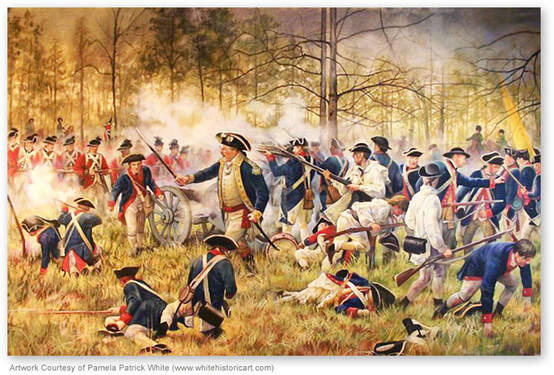
Did you ever wonder what happens "after" the many battle engagements and skirmishers to all the soldiers who were killed throughout the Revolutionary War?
The NJ American Revolution Geo Trail profiles many church cemeteries with Patriots graves, these are the lucky ones who died near a church, as you will learn what happened post battle to others in the topic links below.
Throughout the course of the war, an estimated 6,800 Americans were killed in action, 6,100 wounded, and upwards of 20,000 were taken prisoner. Historians believe that at least an additional 17,000 deaths were the result of disease, including about 8,000–12,000 who died while prisoners of war.
Unreliable imperial data places the total casualties for British regulars fighting in the Revolutionary War around 24,000 men. This total number includes battlefield deaths and injuries, deaths from disease, men taken prisoner, and those who remained missing.
Approximately 1,200 Hessian soldiers were killed, 6,354 died of disease, and another 5,500 deserted and settled in America afterward.
The NJ American Revolution Geo Trail profiles many church cemeteries with Patriots graves, these are the lucky ones who died near a church, as you will learn what happened post battle to others in the topic links below.
Throughout the course of the war, an estimated 6,800 Americans were killed in action, 6,100 wounded, and upwards of 20,000 were taken prisoner. Historians believe that at least an additional 17,000 deaths were the result of disease, including about 8,000–12,000 who died while prisoners of war.
Unreliable imperial data places the total casualties for British regulars fighting in the Revolutionary War around 24,000 men. This total number includes battlefield deaths and injuries, deaths from disease, men taken prisoner, and those who remained missing.
Approximately 1,200 Hessian soldiers were killed, 6,354 died of disease, and another 5,500 deserted and settled in America afterward.
Revolutionary War Military Burials topic with video and article
Historian Robert Selig talked about the practice of burying the dead during the Revolutionary War. He discussed how loved ones identified the bodies, and the influence of military rank and religion on the burials. His informative article “In the Morning We Began to Strip and Bury the Dead:” is also linked below.
The American Revolution Institute of the Society of the Cincinnati hosted this event.
1:16 minute presentation video link
“In the Morning We Began to Strip and Bury the Dead:” A Context for Burial Practices During the American War for Independence Robert A. Selig1 and Wade P. Catts 2
ARTICLE LINK HERE
https://www.americanrevolutioninstitute.org
Historian Robert Selig talked about the practice of burying the dead during the Revolutionary War. He discussed how loved ones identified the bodies, and the influence of military rank and religion on the burials. His informative article “In the Morning We Began to Strip and Bury the Dead:” is also linked below.
The American Revolution Institute of the Society of the Cincinnati hosted this event.
1:16 minute presentation video link
“In the Morning We Began to Strip and Bury the Dead:” A Context for Burial Practices During the American War for Independence Robert A. Selig1 and Wade P. Catts 2
ARTICLE LINK HERE
https://www.americanrevolutioninstitute.org
A New Jersey Revolutionary War Location Profile
Why is the British Union Jack flying over New Jersey?
And the lost tomb of Sandy Hook
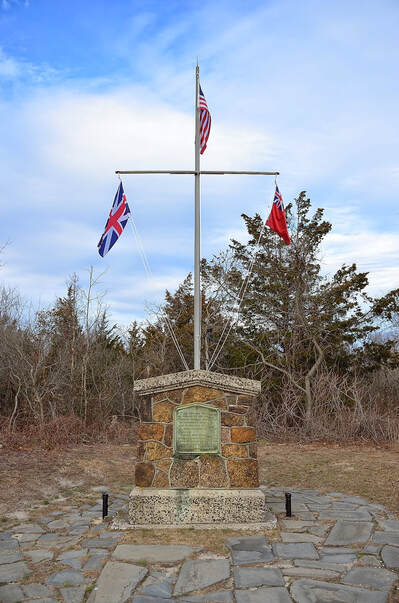
The Halyburton memorial is located Just before you get to Fort Hancock on Sandy Hook. There you will see a stone memorial with a replica ship's mast which holds the American flag, British Union Jack, and the Red Ensign flown by the Royal Navy. Why is the flag of the United Kingdom being flown in NJ at what used to be a United States Army base?
The Sandy Hook Lighthouse was commandeered by British troops during the American Revolution, but that doesn't have much to do with the story. Instead, this unusually-placed pole and monument memorializes the deaths of several crew of the HMS Assistance at Sandy Hook more than a year after the British Parliament voted to end the war and armed hostilities had pretty much come to an end.
Their deaths came not as the result of enemy fire or rough seas, but from the weather and possibly poor planning. The Assistance had been one of many British vessels stationed in and around New York Harbor, and in late December 1783 she was anchored in Sandy Hook Bay in preparation for the Navy's departure from the newly-victorious United States. Capitalizing on the proximity to land, several of the ship's crew decided to desert.
When their absence was discovered, the ship's captain ordered a recovery team to search Sandy Hook for the errant sailors. Led by Lieutenant Hamilton Douglas Halyburton, 12 crew members made their way to the Hook to begin their search on December 31. It's not clear whether they found any of the deserters; what is known is that Halyburton's group became trapped by a snowstorm, and all died of exposure.
According to the Park Service wayside marker near the memorial, the remains of the unfortunate party lay at the site of the memorial untouched until 1909 when workmen at Fort Hancock discovered them. They were moved to Cypress Hills National Cemetery in Brooklyn, which also holds the graves of Civil War Soldiers (both sides) and a memorial to the War of 1812. While the men of the Assistance are no longer present on Sandy Hook, the Depression-era Civilian Conservation Corps built a monument in their memory. The stone marker, made from local puddingstone, includes a plaque that tells the story of Halyburton and his search party, leaving out the part about the deserters.
You have to wonder: did the searchers find any of the deserters? If not, did any of the deserters survive? Could there still be remains of unhappy, frostbitten former British soldiers in the salt marshes of Sandy Hook?
Another article link
The story behind the mutiny of the Pennsylvania Line
Morristown National Park @ Jockey Hollow
"Where America Survived"
Morristown National Historical Park commemorates the sites of General Washington and the Continental army’s winter encampment of December.1779 to June 1780, where they survived through what would be the coldest winter on record. The park also maintains a museum & library collection related to the encampments & George Washington, as well as items relating to pre- and post-Revolutionary America. Link
Morristown National Historical Park commemorates the sites of General Washington and the Continental army’s winter encampment of December.1779 to June 1780, where they survived through what would be the coldest winter on record. The park also maintains a museum & library collection related to the encampments & George Washington, as well as items relating to pre- and post-Revolutionary America. Link

